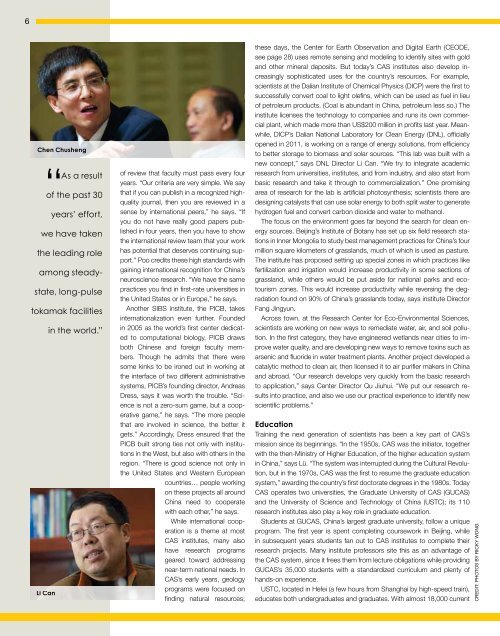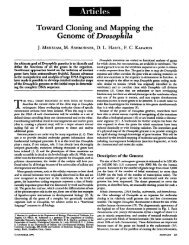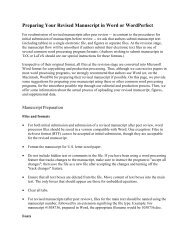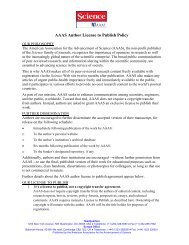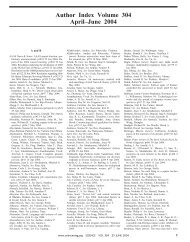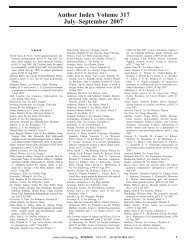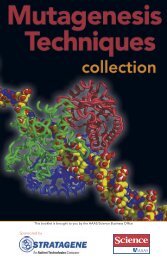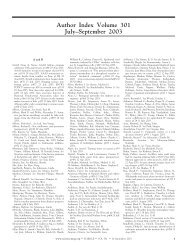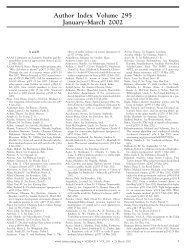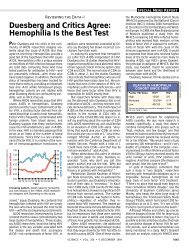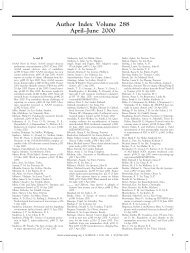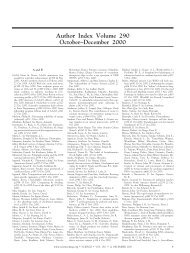Chinese Academy of Sciences (PDF) - low res version
Chinese Academy of Sciences (PDF) - low res version
Chinese Academy of Sciences (PDF) - low res version
Create successful ePaper yourself
Turn your PDF publications into a flip-book with our unique Google optimized e-Paper software.
6<br />
Chen Chusheng<br />
“As a <strong>res</strong>ult<br />
<strong>of</strong> the past 30<br />
years’ effort,<br />
we have taken<br />
the leading role<br />
among steady-<br />
state, long-pulse<br />
tokamak facilities<br />
Li Can<br />
in the world.”<br />
<strong>of</strong> review that faculty must pass every four<br />
years. “Our criteria are very simple. We say<br />
that if you can publish in a recognized highquality<br />
journal, then you are reviewed in a<br />
sense by international peers,” he says. “If<br />
you do not have really good papers published<br />
in four years, then you have to show<br />
the international review team that your work<br />
has potential that deserves continuing support.”<br />
Poo credits these high standards with<br />
gaining international recognition for China’s<br />
neuroscience <strong>res</strong>earch. “We have the same<br />
practices you find in first-rate universities in<br />
the United States or in Europe,” he says.<br />
Another SIBS institute, the PICB, takes<br />
internationalization even further. Founded<br />
in 2005 as the world’s first center dedicated<br />
to computational biology, PICB draws<br />
both <strong>Chinese</strong> and foreign faculty members.<br />
Though he admits that there were<br />
some kinks to be ironed out in working at<br />
the interface <strong>of</strong> two different administrative<br />
systems, PICB’s founding director, Andreas<br />
D<strong>res</strong>s, says it was worth the trouble. “Science<br />
is not a zero-sum game, but a cooperative<br />
game,” he says. “The more people<br />
that are involved in science, the better it<br />
gets.” Accordingly, D<strong>res</strong>s ensured that the<br />
PICB built strong ties not only with institutions<br />
in the West, but also with others in the<br />
region. “There is good science not only in<br />
the United States and Western European<br />
countries… people working<br />
on these projects all around<br />
China need to cooperate<br />
with each other,” he says.<br />
While international cooperation<br />
is a theme at most<br />
CAS institutes, many also<br />
have <strong>res</strong>earch programs<br />
geared toward add<strong>res</strong>sing<br />
near-term national needs. In<br />
CAS’s early years, geology<br />
programs were focused on<br />
finding natural <strong>res</strong>ources;<br />
these days, the Center for Earth Observation and Digital Earth (CEODE,<br />
see page 28) uses remote sensing and modeling to identify sites with gold<br />
and other mineral deposits. But today’s CAS institutes also develop increasingly<br />
sophisticated uses for the country’s <strong>res</strong>ources. For example,<br />
scientists at the Dalian Institute <strong>of</strong> Chemical Physics (DICP) were the first to<br />
successfully convert coal to light olefins, which can be used as fuel in lieu<br />
<strong>of</strong> petroleum products. (Coal is abundant in China, petroleum less so.) The<br />
institute licenses the technology to companies and runs its own commercial<br />
plant, which made more than US$200 million in pr<strong>of</strong>its last year. Meanwhile,<br />
DICP’s Dalian National Laboratory for Clean Energy (DNL), <strong>of</strong>ficially<br />
opened in 2011, is working on a range <strong>of</strong> energy solutions, from efficiency<br />
to better storage to biomass and solar sources. “This lab was built with a<br />
new concept,” says DNL Director Li Can. “We try to integrate academic<br />
<strong>res</strong>earch from universities, institutes, and from industry, and also start from<br />
basic <strong>res</strong>earch and take it through to commercialization.” One promising<br />
area <strong>of</strong> <strong>res</strong>earch for the lab is artificial photosynthesis; scientists there are<br />
designing catalysts that can use solar energy to both split water to generate<br />
hydrogen fuel and convert carbon dioxide and water to methanol.<br />
The focus on the environment goes far beyond the search for clean energy<br />
sources. Beijing’s Institute <strong>of</strong> Botany has set up six field <strong>res</strong>earch stations<br />
in Inner Mongolia to study best management practices for China’s four<br />
million square kilometers <strong>of</strong> grasslands, much <strong>of</strong> which is used as pasture.<br />
The institute has proposed setting up special zones in which practices like<br />
fertilization and irrigation would increase productivity in some sections <strong>of</strong><br />
grassland, while others would be put aside for national parks and ecotourism<br />
zones. This would increase productivity while reversing the degradation<br />
found on 90% <strong>of</strong> China’s grasslands today, says institute Director<br />
Fang Jingyun.<br />
Across town, at the Research Center for Eco-Environmental <strong>Sciences</strong>,<br />
scientists are working on new ways to remediate water, air, and soil pollution.<br />
In the first category, they have engineered wetlands near cities to improve<br />
water quality, and are developing new ways to remove toxins such as<br />
arsenic and fluoride in water treatment plants. Another project developed a<br />
catalytic method to clean air, then licensed it to air purifier makers in China<br />
and abroad. “Our <strong>res</strong>earch develops very quickly from the basic <strong>res</strong>earch<br />
to application,” says Center Director Qu Jiuhui. “We put our <strong>res</strong>earch <strong>res</strong>ults<br />
into practice, and also we use our practical experience to identify new<br />
scientific problems.”<br />
Education<br />
Training the next generation <strong>of</strong> scientists has been a key part <strong>of</strong> CAS’s<br />
mission since its beginnings. “In the 1950s, CAS was the initiator, together<br />
with the then-Ministry <strong>of</strong> Higher Education, <strong>of</strong> the higher education system<br />
in China,” says Lü. “The system was interrupted during the Cultural Revolution,<br />
but in the 1970s, CAS was the first to <strong>res</strong>ume the graduate education<br />
system,” awarding the country’s first doctorate degrees in the 1980s. Today<br />
CAS operates two universities, the Graduate University <strong>of</strong> CAS (GUCAS)<br />
and the University <strong>of</strong> Science and Technology <strong>of</strong> China (USTC); its 110<br />
<strong>res</strong>earch institutes also play a key role in graduate education.<br />
Students at GUCAS, China’s largest graduate university, fol<strong>low</strong> a unique<br />
program. The first year is spent completing coursework in Beijing, while<br />
in subsequent years students fan out to CAS institutes to complete their<br />
<strong>res</strong>earch projects. Many institute pr<strong>of</strong>essors site this as an advantage <strong>of</strong><br />
the CAS system, since it frees them from lecture obligations while providing<br />
GUCAS’s 35,000 students with a standardized curriculum and plenty <strong>of</strong><br />
hands-on experience.<br />
USTC, located in Hefei (a few hours from Shanghai by high-speed train),<br />
educates both undergraduates and graduates. With almost 18,000 current<br />
CREDIT: PHOTOS BY RICKY WONG


